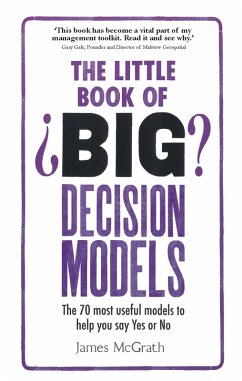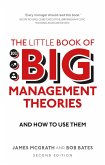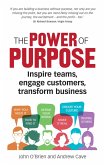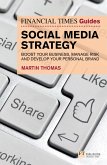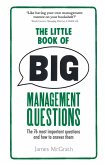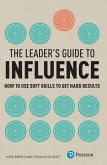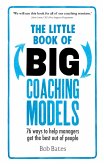James Mcgrath
Little Book of Big Decision Models, The (eBook, ePUB)
The 70 Most Useful Models To Help You Say Yes Or No
10,95 €
10,95 €
inkl. MwSt.
Sofort per Download lieferbar

5 °P sammeln
10,95 €
Als Download kaufen

10,95 €
inkl. MwSt.
Sofort per Download lieferbar

5 °P sammeln
Jetzt verschenken
Alle Infos zum eBook verschenken
10,95 €
inkl. MwSt.
Sofort per Download lieferbar
Alle Infos zum eBook verschenken

5 °P sammeln
James Mcgrath
Little Book of Big Decision Models, The (eBook, ePUB)
The 70 Most Useful Models To Help You Say Yes Or No
- Format: ePub
- Merkliste
- Auf die Merkliste
- Bewerten Bewerten
- Teilen
- Produkt teilen
- Produkterinnerung
- Produkterinnerung

Bitte loggen Sie sich zunächst in Ihr Kundenkonto ein oder registrieren Sie sich bei
bücher.de, um das eBook-Abo tolino select nutzen zu können.
Hier können Sie sich einloggen
Hier können Sie sich einloggen
Sie sind bereits eingeloggt. Klicken Sie auf 2. tolino select Abo, um fortzufahren.

Bitte loggen Sie sich zunächst in Ihr Kundenkonto ein oder registrieren Sie sich bei bücher.de, um das eBook-Abo tolino select nutzen zu können.
Leaders and Managerswant quick answers, quick ways to reach solutions, ways and means to access knowledge that won't eat into their precious time and quick ideas that deliver a big result. The Little Book of Big Decision Models cuts through all the noise and gives managers access to the very best decision-making models that they need to to keep things moving forward. Every model is quick and easy to read and delivers the essential information and know-how quickly, efficiently and memorably.
- Geräte: eReader
- ohne Kopierschutz
- eBook Hilfe
Andere Kunden interessierten sich auch für
![Little Book of Big Management Theories, The (eBook, ePUB) Little Book of Big Management Theories, The (eBook, ePUB)]() James McgrathLittle Book of Big Management Theories, The (eBook, ePUB)10,95 €
James McgrathLittle Book of Big Management Theories, The (eBook, ePUB)10,95 €![Power of Purpose, The (eBook, ePUB) Power of Purpose, The (eBook, ePUB)]() John O'BrienPower of Purpose, The (eBook, ePUB)11,95 €
John O'BrienPower of Purpose, The (eBook, ePUB)11,95 €![Financial Times Guide to Social Media Strategy, The (eBook, ePUB) Financial Times Guide to Social Media Strategy, The (eBook, ePUB)]() Martin ThomasFinancial Times Guide to Social Media Strategy, The (eBook, ePUB)18,95 €
Martin ThomasFinancial Times Guide to Social Media Strategy, The (eBook, ePUB)18,95 €![Financial Times Guide to Leadership, The (eBook, ePUB) Financial Times Guide to Leadership, The (eBook, ePUB)]() Marianne Abib PechFinancial Times Guide to Leadership, The (eBook, ePUB)16,95 €
Marianne Abib PechFinancial Times Guide to Leadership, The (eBook, ePUB)16,95 €![Little Book of Big Management Questions, The (eBook, ePUB) Little Book of Big Management Questions, The (eBook, ePUB)]() James McgrathLittle Book of Big Management Questions, The (eBook, ePUB)11,95 €
James McgrathLittle Book of Big Management Questions, The (eBook, ePUB)11,95 €![Leader's Guide to Influence, The (eBook, ePUB) Leader's Guide to Influence, The (eBook, ePUB)]() Fiona DentLeader's Guide to Influence, The (eBook, ePUB)13,95 €
Fiona DentLeader's Guide to Influence, The (eBook, ePUB)13,95 €![The Little Book of Big Coaching Models PDF eBook: 83 ways to help managers get the best out of people (eBook, ePUB) The Little Book of Big Coaching Models PDF eBook: 83 ways to help managers get the best out of people (eBook, ePUB)]() Bob BatesThe Little Book of Big Coaching Models PDF eBook: 83 ways to help managers get the best out of people (eBook, ePUB)11,95 €
Bob BatesThe Little Book of Big Coaching Models PDF eBook: 83 ways to help managers get the best out of people (eBook, ePUB)11,95 €-
-
-
Leaders and Managerswant quick answers, quick ways to reach solutions, ways and means to access knowledge that won't eat into their precious time and quick ideas that deliver a big result. The Little Book of Big Decision Models cuts through all the noise and gives managers access to the very best decision-making models that they need to to keep things moving forward. Every model is quick and easy to read and delivers the essential information and know-how quickly, efficiently and memorably.
Dieser Download kann aus rechtlichen Gründen nur mit Rechnungsadresse in A, B, BG, CY, CZ, D, DK, EW, E, FIN, F, GR, HR, H, IRL, I, LT, L, LR, M, NL, PL, P, R, S, SLO, SK ausgeliefert werden.
Produktdetails
- Produktdetails
- Verlag: Pearson HigherEducation
- Seitenzahl: 224
- Altersempfehlung: ab 18 Jahre
- Erscheinungstermin: 17. November 2015
- Englisch
- ISBN-13: 9781292098388
- Artikelnr.: 44229100
- Verlag: Pearson HigherEducation
- Seitenzahl: 224
- Altersempfehlung: ab 18 Jahre
- Erscheinungstermin: 17. November 2015
- Englisch
- ISBN-13: 9781292098388
- Artikelnr.: 44229100
- Herstellerkennzeichnung Die Herstellerinformationen sind derzeit nicht verfügbar.
James McGrath worked as an accountant and senior manager in industry, local government and as a self-employed management consultant before becoming Course Director for the MA in Education and Professional Development at the City of Birmingham University.
* Chapter 1 - The principles of decision making
* Introduction
* Model 1: Townsend’s rules of decision making
* Model 2: The McNamara fallacy - The vital information that decision
makers ignore
* Model 3: Using quantitative (hard) and qualitative (soft) data in
decision making
* Model 4: Kreiner and Christensen the consequence model
* Model 5: Tenenbaum and Schmid’s decision making spectrum
* Model 6: Roger and Blenko’s rapid decision making model
* Model 7: Cognitive mapping - understanding how your colleagues think
* Model 8: Tacit knowledge and decision making
* Model 9: The standard decision making model
* Conclusion
* Chapter 2 - Using data in decision making
* Introduction
* Model 10: The Pareto principle and the important vital few
* Model 11: Lewin’s force field analysis of the support and opposition
to a decision
* Model 12: Scenario analysis and charting possible futures
* Model 13: Delphic forecasting and how to firm up predictions
* Model 14: Johnson, Scholes and Wittingham mapping stakeholder’s
reactions
* Model 15: Egan’s shadow side model - dealing with the politics of
decisions
* Model 16: The SCAMPER model and finding creative solutions
* Model 17: De Bono’s six thinking hats - generating different
perspectives
* Conclusions
* Chapter 3 - Enhancing your decision making skills
* Intrduction
* Model 18: The Eisenhower principle and the delegation of decisions
* Model 19: The feedback and criticism grid
* Model 20: Learning to think outside the box
* Model 21: Goleman: Using emotional intelligence to make better
decisions
* Model 22: Sumantra and Bruch reclaiming your job
* Conclusion
* Chapter 4 - Decisions models about you
* Introduction
* Model 23: Christensen’s strategy for a happy life
* Model 24: The making – of you model and how your past influences the
present
* Model 25: The rubber band model - what holds you back and pulls you
forward?
* Model 26: The crossroads model and which road to follow next
* Model 27: The personal performance model and job satisfaction
* Model 28: Csikzenmihalyi’s flow model and the joy of working in ‘the
zone’
* Model 29: Maslow’s Pyramids - what you want and what you need
* Model 30: The Euffe Elbaek model - a guide to your personality
* Model 31: Johari windows - a guide to your personality
* Model 32: The personal potential trap and how to avoid becoming a
prisoner of other peoples’ expectations
* Model 33: Your attitude to risk
* Conclusion
* Chapter 5 - Decision Models about other people
* Introduction
* Model 34: Goffee and Jones - why should anyone be led by you?
* Model 35: Hersey and Blanchard’s situational leadership model
* Model 36: Manzoni and Barsoux - how managers set staff up to fail
* Model 37: Denseraeu, Graen and Haga - how managers set staff up to
succeed
* Model 38: Herzberg’s motivation and hygiene theory - choosing the
right carrots
* Model 39: The feedback sandwich - delivering negative feedback
* Model 40: McGregor’s features of effective and ineffective teams
* Model 41: The team model - building a well balanced team
* Conclusion
* Cha
* Introduction
* Model 1: Townsend’s rules of decision making
* Model 2: The McNamara fallacy - The vital information that decision
makers ignore
* Model 3: Using quantitative (hard) and qualitative (soft) data in
decision making
* Model 4: Kreiner and Christensen the consequence model
* Model 5: Tenenbaum and Schmid’s decision making spectrum
* Model 6: Roger and Blenko’s rapid decision making model
* Model 7: Cognitive mapping - understanding how your colleagues think
* Model 8: Tacit knowledge and decision making
* Model 9: The standard decision making model
* Conclusion
* Chapter 2 - Using data in decision making
* Introduction
* Model 10: The Pareto principle and the important vital few
* Model 11: Lewin’s force field analysis of the support and opposition
to a decision
* Model 12: Scenario analysis and charting possible futures
* Model 13: Delphic forecasting and how to firm up predictions
* Model 14: Johnson, Scholes and Wittingham mapping stakeholder’s
reactions
* Model 15: Egan’s shadow side model - dealing with the politics of
decisions
* Model 16: The SCAMPER model and finding creative solutions
* Model 17: De Bono’s six thinking hats - generating different
perspectives
* Conclusions
* Chapter 3 - Enhancing your decision making skills
* Intrduction
* Model 18: The Eisenhower principle and the delegation of decisions
* Model 19: The feedback and criticism grid
* Model 20: Learning to think outside the box
* Model 21: Goleman: Using emotional intelligence to make better
decisions
* Model 22: Sumantra and Bruch reclaiming your job
* Conclusion
* Chapter 4 - Decisions models about you
* Introduction
* Model 23: Christensen’s strategy for a happy life
* Model 24: The making – of you model and how your past influences the
present
* Model 25: The rubber band model - what holds you back and pulls you
forward?
* Model 26: The crossroads model and which road to follow next
* Model 27: The personal performance model and job satisfaction
* Model 28: Csikzenmihalyi’s flow model and the joy of working in ‘the
zone’
* Model 29: Maslow’s Pyramids - what you want and what you need
* Model 30: The Euffe Elbaek model - a guide to your personality
* Model 31: Johari windows - a guide to your personality
* Model 32: The personal potential trap and how to avoid becoming a
prisoner of other peoples’ expectations
* Model 33: Your attitude to risk
* Conclusion
* Chapter 5 - Decision Models about other people
* Introduction
* Model 34: Goffee and Jones - why should anyone be led by you?
* Model 35: Hersey and Blanchard’s situational leadership model
* Model 36: Manzoni and Barsoux - how managers set staff up to fail
* Model 37: Denseraeu, Graen and Haga - how managers set staff up to
succeed
* Model 38: Herzberg’s motivation and hygiene theory - choosing the
right carrots
* Model 39: The feedback sandwich - delivering negative feedback
* Model 40: McGregor’s features of effective and ineffective teams
* Model 41: The team model - building a well balanced team
* Conclusion
* Cha
* Chapter 1 - The principles of decision making
* Introduction
* Model 1: Townsend’s rules of decision making
* Model 2: The McNamara fallacy - The vital information that decision
makers ignore
* Model 3: Using quantitative (hard) and qualitative (soft) data in
decision making
* Model 4: Kreiner and Christensen the consequence model
* Model 5: Tenenbaum and Schmid’s decision making spectrum
* Model 6: Roger and Blenko’s rapid decision making model
* Model 7: Cognitive mapping - understanding how your colleagues think
* Model 8: Tacit knowledge and decision making
* Model 9: The standard decision making model
* Conclusion
* Chapter 2 - Using data in decision making
* Introduction
* Model 10: The Pareto principle and the important vital few
* Model 11: Lewin’s force field analysis of the support and opposition
to a decision
* Model 12: Scenario analysis and charting possible futures
* Model 13: Delphic forecasting and how to firm up predictions
* Model 14: Johnson, Scholes and Wittingham mapping stakeholder’s
reactions
* Model 15: Egan’s shadow side model - dealing with the politics of
decisions
* Model 16: The SCAMPER model and finding creative solutions
* Model 17: De Bono’s six thinking hats - generating different
perspectives
* Conclusions
* Chapter 3 - Enhancing your decision making skills
* Intrduction
* Model 18: The Eisenhower principle and the delegation of decisions
* Model 19: The feedback and criticism grid
* Model 20: Learning to think outside the box
* Model 21: Goleman: Using emotional intelligence to make better
decisions
* Model 22: Sumantra and Bruch reclaiming your job
* Conclusion
* Chapter 4 - Decisions models about you
* Introduction
* Model 23: Christensen’s strategy for a happy life
* Model 24: The making – of you model and how your past influences the
present
* Model 25: The rubber band model - what holds you back and pulls you
forward?
* Model 26: The crossroads model and which road to follow next
* Model 27: The personal performance model and job satisfaction
* Model 28: Csikzenmihalyi’s flow model and the joy of working in ‘the
zone’
* Model 29: Maslow’s Pyramids - what you want and what you need
* Model 30: The Euffe Elbaek model - a guide to your personality
* Model 31: Johari windows - a guide to your personality
* Model 32: The personal potential trap and how to avoid becoming a
prisoner of other peoples’ expectations
* Model 33: Your attitude to risk
* Conclusion
* Chapter 5 - Decision Models about other people
* Introduction
* Model 34: Goffee and Jones - why should anyone be led by you?
* Model 35: Hersey and Blanchard’s situational leadership model
* Model 36: Manzoni and Barsoux - how managers set staff up to fail
* Model 37: Denseraeu, Graen and Haga - how managers set staff up to
succeed
* Model 38: Herzberg’s motivation and hygiene theory - choosing the
right carrots
* Model 39: The feedback sandwich - delivering negative feedback
* Model 40: McGregor’s features of effective and ineffective teams
* Model 41: The team model - building a well balanced team
* Conclusion
* Cha
* Introduction
* Model 1: Townsend’s rules of decision making
* Model 2: The McNamara fallacy - The vital information that decision
makers ignore
* Model 3: Using quantitative (hard) and qualitative (soft) data in
decision making
* Model 4: Kreiner and Christensen the consequence model
* Model 5: Tenenbaum and Schmid’s decision making spectrum
* Model 6: Roger and Blenko’s rapid decision making model
* Model 7: Cognitive mapping - understanding how your colleagues think
* Model 8: Tacit knowledge and decision making
* Model 9: The standard decision making model
* Conclusion
* Chapter 2 - Using data in decision making
* Introduction
* Model 10: The Pareto principle and the important vital few
* Model 11: Lewin’s force field analysis of the support and opposition
to a decision
* Model 12: Scenario analysis and charting possible futures
* Model 13: Delphic forecasting and how to firm up predictions
* Model 14: Johnson, Scholes and Wittingham mapping stakeholder’s
reactions
* Model 15: Egan’s shadow side model - dealing with the politics of
decisions
* Model 16: The SCAMPER model and finding creative solutions
* Model 17: De Bono’s six thinking hats - generating different
perspectives
* Conclusions
* Chapter 3 - Enhancing your decision making skills
* Intrduction
* Model 18: The Eisenhower principle and the delegation of decisions
* Model 19: The feedback and criticism grid
* Model 20: Learning to think outside the box
* Model 21: Goleman: Using emotional intelligence to make better
decisions
* Model 22: Sumantra and Bruch reclaiming your job
* Conclusion
* Chapter 4 - Decisions models about you
* Introduction
* Model 23: Christensen’s strategy for a happy life
* Model 24: The making – of you model and how your past influences the
present
* Model 25: The rubber band model - what holds you back and pulls you
forward?
* Model 26: The crossroads model and which road to follow next
* Model 27: The personal performance model and job satisfaction
* Model 28: Csikzenmihalyi’s flow model and the joy of working in ‘the
zone’
* Model 29: Maslow’s Pyramids - what you want and what you need
* Model 30: The Euffe Elbaek model - a guide to your personality
* Model 31: Johari windows - a guide to your personality
* Model 32: The personal potential trap and how to avoid becoming a
prisoner of other peoples’ expectations
* Model 33: Your attitude to risk
* Conclusion
* Chapter 5 - Decision Models about other people
* Introduction
* Model 34: Goffee and Jones - why should anyone be led by you?
* Model 35: Hersey and Blanchard’s situational leadership model
* Model 36: Manzoni and Barsoux - how managers set staff up to fail
* Model 37: Denseraeu, Graen and Haga - how managers set staff up to
succeed
* Model 38: Herzberg’s motivation and hygiene theory - choosing the
right carrots
* Model 39: The feedback sandwich - delivering negative feedback
* Model 40: McGregor’s features of effective and ineffective teams
* Model 41: The team model - building a well balanced team
* Conclusion
* Cha
